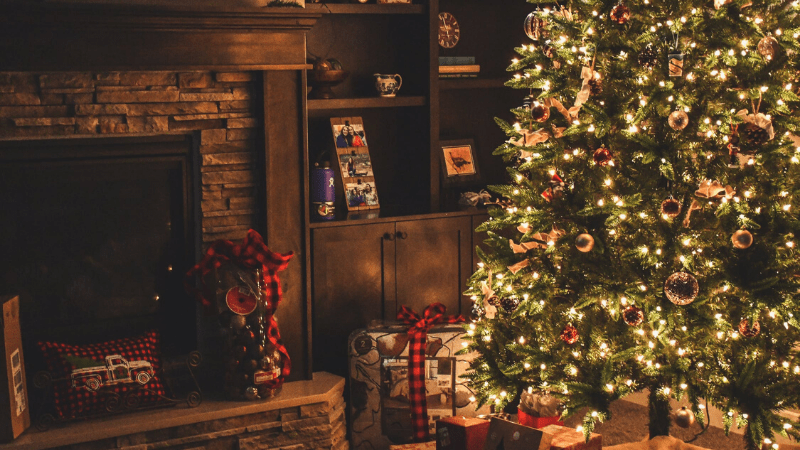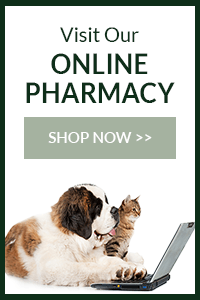8 days until Christmas! As we mentioned yesterday, we are going to post each day about a common holiday item that could be dangerous to your pets. Our first post discussed chocolate toxicity. Today we’d like to share some information about Christmas trees and tree preservatives.
*Allow 3-5 minutes to read the full post.
From Thanksgiving until New Years, many of us decorate our home with beautiful live Christmas trees. Having a live tree is somewhat magical, but there are a few things to be aware of if you have pets living in your home.
Do you use a preservative on your tree? Preservatives usually contain fertilizer and occasionally a fungicide. These items are poisonous if consumed in large amounts, and will often cause GI upset and vomiting if ingested in small amounts. If your pet is tempted to drink the water out of the Christmas tree stand, you may want to go preservative-free. A live tree can thrive without any preservatives at all. Here are some tips to making sure your Christmas tree looks gorgeous all season long:
🌲Pick a tree that looks fresh. Avoid trees with browning needles, and give the tree a good shake before you purchase it… does a big pile of needles fall off? If so, move along to another one.
🌲Set up your tree as soon as possible. If you can’t get the tree in its stand right away, keep it in a cool place out of the wind. Try to avoid storing it in temperatures below freezing, or for more than 24 hours.
🌲Before you put the tree in its stand, cut off a 1-inch section from the bottom of the trunk.
🌲Water your tree immediately once it’s standing. Make sure you have a tree stand that holds at least a gallon of water (the bottom two inches or more of the tree turn should be in water). Check the water level daily.
🌲Christmas trees like cooler temperatures. Try to place your tree close to a window and away from radiators, heat vents and fireplaces.
Another thing to consider — the water in the Christmas tree stand sits stagnant for days, a perfect home for bacteria to grow. Pets that drink water out of the tree base could develop nausea, vomiting or diarrhea from bacterial contamination. Try to keep the bottom of your tree covered so that pets aren’t tempted to stick their tongues in the water.
Do you use a preservative on your tree? Preservatives usually contain fertilizer and occasionally a fungicide. These items are poisonous if consumed in large amounts, and will often cause GI upset and vomiting if ingested in small amounts. If your pet is tempted to drink the water out of the Christmas tree stand, you may want to go preservative-free. A live tree can thrive without any preservatives at all. Here are some tips to making sure your Christmas tree looks gorgeous all season long:
🌲Pick a tree that looks fresh. Avoid trees with browning needles, and give the tree a good shake before you purchase it… does a big pile of needles fall off? If so, move along to another one.
🌲Set up your tree as soon as possible. If you can’t get the tree in its stand right away, keep it in a cool place out of the wind. Try to avoid storing it in temperatures below freezing, or for more than 24 hours.
🌲Before you put the tree in its stand, cut off a 1-inch section from the bottom of the trunk.
🌲Water your tree immediately once it’s standing. Make sure you have a tree stand that holds at least a gallon of water (the bottom two inches or more of the tree turn should be in water). Check the water level daily.
🌲Christmas trees like cooler temperatures. Try to place your tree close to a window and away from radiators, heat vents and fireplaces.
Another thing to consider — the water in the Christmas tree stand sits stagnant for days, a perfect home for bacteria to grow. Pets that drink water out of the tree base could develop nausea, vomiting or diarrhea from bacterial contamination. Try to keep the bottom of your tree covered so that pets aren’t tempted to stick their tongues in the water.
If you think your pet is sick from drinking Christmas tree water, call the Pet Poison Helpline at
855-764-7661.
While we’re on the topic of living plants that pose risks for pets… make sure to read our poinsettia post from December 11th if you haven’t already! Tune in tomorrow for information about some common winter medications that are toxic to pets.
855-764-7661.
While we’re on the topic of living plants that pose risks for pets… make sure to read our poinsettia post from December 11th if you haven’t already! Tune in tomorrow for information about some common winter medications that are toxic to pets.






